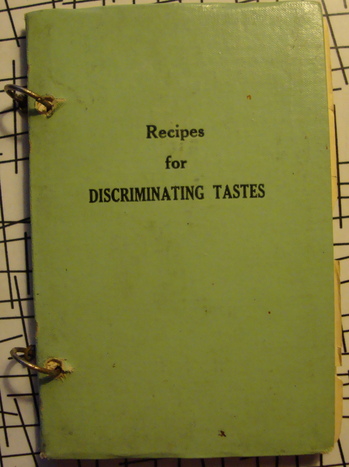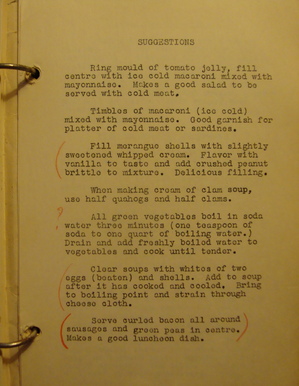The Mystery of the Little Green Cookbook


Mary Bilyeu, Contributor
It is fascinating, asking and answering questions as I pore through the pages, wishing I had more information while trying to put the scant tidbits and pieces together to learn more about the person who compiled it.
The book is titled "Recipes for Discriminating Tastes" and has no author, no date, no publishing information, no inscription … nothin'. It is a collection of typed recipes - typed, not printed - that clearly were written by an individual rather than this being a published work. It is very old, indicated not only by the typing but also by the yellowing pages; the rings holding it together (it's not a binder, but rather is a set of papers between two covers and kept intact by two rings); and the types of recipes offered - nothing microwaved, no food processors required, with items like aspic and Ice-Box Cookies among the options.
And so, how did this book manage to find its way to Stone High School? Did it belong to one of the item donors, and did this person realize that it was in the box or bag being dropped off? Did they rid themselves of it because it was old and antiquated, not suited to our modern era in which time and drive-thru convenience are of the essence? Or did they accidentally - and regrettably - give away a priceless family heirloom, handed down from a parent and a grandparent, if not a great-grandparent?
Or, perhaps, did the author - presumably a woman, given the times this book seems to come from - lose either her life or her independence, and someone sorting through the remnants she left behind when she either died or moved to an assisted care facility simply didn't appreciate the value this book had? I don't know … I have no idea how this small and frail treasure found its way to a box at a sale in the high school gym. And so, I find myself trying to find out more about the typist/author.
As I've said, I presume I'm reading the work of a woman. She seems to be European, and most likely British; she writes “centre” and “Unmould” and “savoury,” and offers a recipe for "A Very Good Appetizer" which calls for "Bloater paste." Now I know about a fair number of obscure ingredients, I must say, but this was a new one to me; and so, I looked it up. It is a British concoction, "A spread (a form of fish paste), made from bloaters, traditionally eaten on toast with afternoon tea." And there is also a recipe for “Admiral Jellico's Favorite” (admittedly no “u” in “favorite,” to potentially throw off my theory!) - a sweet steamed pudding named after an officer in the British Royal Navy during World War I.

Mary Bilyeu, Contributor
The typing is exceptionally good - only two or three words have any letters typed over, and there is no indication of white-out. Newburg is misspelled once (“Newberg”), though used correctly on several other occasions. So I wonder - did our mystery author once work as a secretary, in some clerical position in which typing was a key skill? She certainly didn't have the benefit of computers to erase her errors! But in addition to the typing, I would have loved to see an inscription, more than just two words in her own handwriting - her name, perhaps the date she received the book and the occasion for it, etc. It's such a loss not to have any of these details!
I imagine that this book was an earlier version of one I once received, in which I can create a cookbook with my own recipes. Was it a gift given to her when she got married, full of empty pages just waiting for her to add recipes as she cooked for her husband? It appears to have all been produced on the same typewriter, so that may or may not be an option; it can't have been typed out in one proverbial fell swoop, but the same machine could have been cared for and maintained such that it would have lasted for years and years as this work progressed.
And how did this book manage to find its way to Ann Arbor or, for that matter, to the United States? Did our author come here and write the book on this side of the ocean? Or did she remain in her homeland, but a child or grandchild who inherited it brought it here? Did she write it in England and bring it with her when she emigrated? And why did she emigrate - did she happen to encounter a young G.I., perhaps, during World War II and marry and come back home with him? That was a common story, once upon a time.
As my brain spins from all the questions that will never be answered, let me leave you with this one last priceless tidbit from the cookbook which has piqued my curiosity. This recipe offers a food item which is rarely served anymore - aspic - containing ingredients not only taboo these days (foie gras) but also rare and expensive (truffles), but priced at a level so inconceivably low that it only makes me wonder more and more about when the book was written, leading to the circular “Who” and “Why” and “When” and “How” that I can't possibly find out ….
Ham in Aspic
Take two tins of puree pate de foie gras (get the 25¢ tins with truffles) and mix together into a paste with one-half Philadelphia cream cheese and a little pepper. Put this mixture in the centre of thin slices of cold cooked ham. Make rolls of the ham and place in a square pan not over two inches deep. Fill the pan with aspic. When icy cold, place on platter and serve with cold slaw salad.
Mary Bilyeu has won or placed in more than 60 cooking contests and writes about her adventures as she tries to win prizes, feeds hungry teenagers and other loved ones and generally just has fun in the kitchen. The phrase "You Should Only Be Happy" (written in Hebrew on the stone pictured next to the blog's title) comes from Deuteronomy 16:15 and is a wish for all her readers as they cook along with her ... may you always be happy here. You can contact Mary at yentamary@gmail.com or follow her on Twitter (twitter.com/foodfloozie). And look for her new food blog: foodfloozie.blogspot.com.


Comments
Mary Bilyeu
Thu, Apr 29, 2010 : 9 a.m.
That's a fabulous idea -- thank you! I keep pondering the possibilities, so maybe someone somewhere could see it and help to solve some of the mysteries!
seldon
Thu, Apr 29, 2010 : 8:31 a.m.
You could scan it and put it online. You might learn a lot more about it that way (and the rest of us could see it too!).